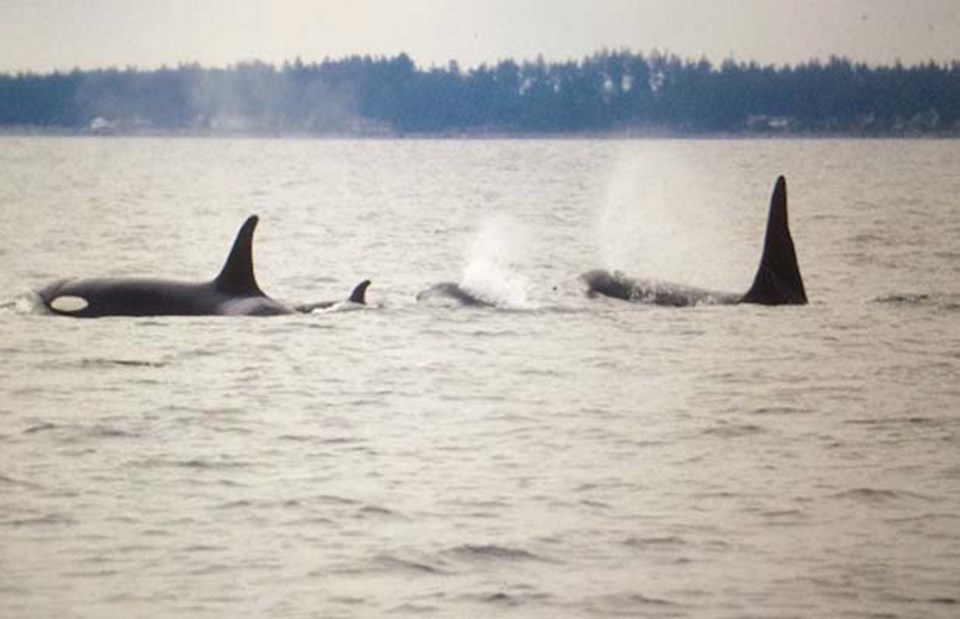While the prime minister and his cabinet colleagues were meeting on the shores of the Salish Sea, it would have been appropriate for them to consider the national treasure that is a candidate for a national marine park or at least our largest marine protected area.
We are blessed with a PM who is a sensitive man, values natural areas and appreciates the importance of protecting them.
He was touched by the 17-day-long display of southern resident orca J35 carrying her dead calf. As a sentient being, she displayed distress over her calf’s death. It was almost as if she was trying to tell us humans something as well. Could she have been pleading with us, who exercise control over her world, to stop polluting her sea? It is likely that her calf died due to the toxins accumulating in orcas — concentrated toxins that are passed on from mother to fetus and, once born via nursing.
No southern resident calves have survived for three years. At 75 orcas, the southern residents are at their lowest population since reliable records have been developed and down from 96 in 1993, a 22 per cent decline. Previous necropsies have shown southern residents to be so loaded with toxins that their corpses could be classified as toxic waste.
We need to treat the southern residents’ plight like the canary in the coal mine. The Salish Sea needs protection, and we humans are the only beings who can and have the responsibility to clean it up — Victoria’s new tertiary sewage plant is a start and sets an example for other cities bordering the Salish Sea. We can’t clean it up tinkering around with tiny, unlinked and unenforced marine protected areas, nor by continuing to allow industries and our practices to contaminate our waters.
Creating the Salish Sea national marine park would signal its value, reinforce its importance in the public mind and provide the incentive and regulatory regime necessary to begin introducing measures to clean up the Salish Sea by eliminating the toxins, protecting the remaining pristine sites, allowing others to recover, restoring habitat — especially salmon breeding grounds — and regulating the various fisheries in the interest of the fish and their ecosystem instead of the fishermen.
Sure there are international concerns, as a good portion of the Salish Sea lies within American waters, but that is an opportunity rather than a reason to hold back. We have several parks joined at border: Waterton/Glacier, the International Peace Garden, Quetico/Boundary Waters, Niagara Falls, etc. And we already have the tiny scattered Gulf Islands National Park Reserve, which could serve as the launching pad for Salish Sea National Marine Park.
Perhaps most importantly, we have in Washington state Gov. Jay Inslee, not only a sympathetic partner, but an active one who has just established a 50-member Orca Task Force to study what we can do to save the orcas with a focus on increasing their food supply — chinook salmon.
If the Salish Sea national marine park is too big a leap for our progressive-minded PM, the least he could do is to create a new Salish Sea marine protected area.
Canada has more coastline than any other country in the world, 265,527 kilometres, according to the World Resources Institute — that is twice as much as the next nation, the U.S. with 133,312, and third-place Russia’s 110,310. On top of that, we have the largest onshore and offshore ocean area under our jurisdiction. Only an insignificant part of this is protected.
We need protected areas in seas adjacent to busy urban areas as much as we need them in our vast remote coastlines. In terms of awareness, the urban ones might be critical.
Should the federal government shy away from protecting the Salish Sea, it presents a wonderful opportunity for the province of B.C. to step in and create the Salish Sea provincial marine park, expanding on the current network of many smaller land-based parks in or adjacent to the Salish Sea. Premier John Horgan has a solid relationship with Inslee, and in their meeting this spring, both committed to enhancing co-operation in the Salish Sea. And B.C. has the jurisdiction to forge ahead on its own if the feds are too timid.
A 1984 Supreme Court decision gave B.C. jurisdiction over the seabed between Vancouver Island and the Mainland, confirming the 1976 decision of the B.C. Court of Appeal, which recognized B.C.’s jurisdiction over the seabed of the Strait of Georgia, Juan de Fuca Strait, Johnston Strait and Queen Charlotte Island, now Haida Gwaii.
So B.C. has the legitimacy in declaring the whole of the Salish Sea and its shorelines a provincial park and marine protected area, with or without Canada’s leadership.
Former premier Dave Barrett will forever be revered for his foresight and courage in establishing B.C.’s Agricultural Land Reserve. Any political leader who steps forward to create a Salish Sea marine park or preserve to protect what is left and enhance the health of the Salish Sea and the denizens of its depths will be similarly regarded by future generations.
Former Manitoba NDP MLA Don Scott was instrumental in the enhancement of Manitoba’s provincial parks system in the 1980s. He has lived in Victoria for 25 years and enjoys exploring the coastline of the Salish Sea by kayak.



